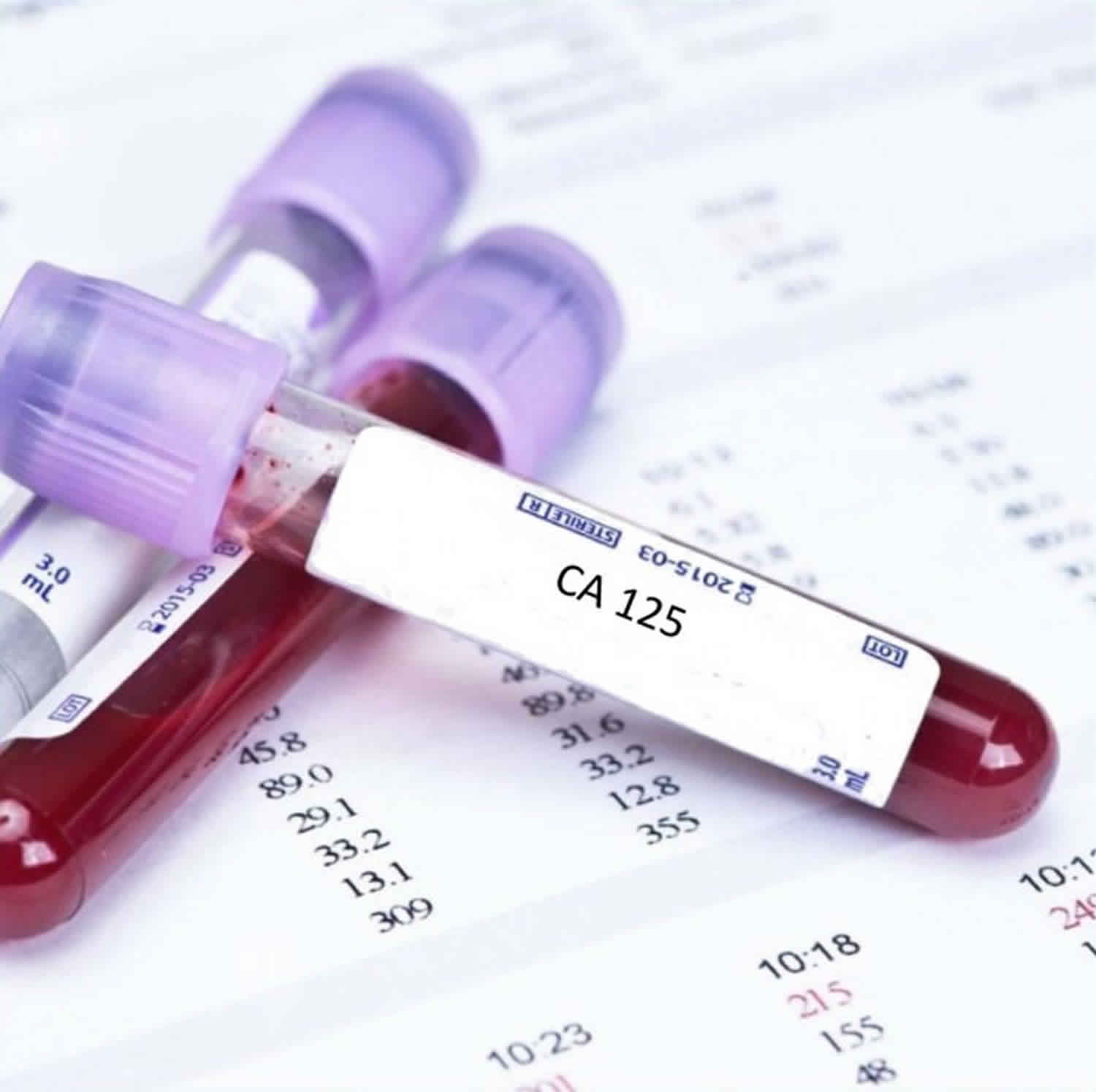Contents
What is CA-125 test
The CA-125 test measures the amount of CA-125 in your blood. CA-125 is short for Cancer Antigen 125, which is a protein that is present on the surface of most, but not all, ovarian cancer cells. This makes the CA-125 test useful as a tumor marker in specific circumstances. Significantly elevated concentrations of CA-125 may be present in the blood of a woman who has ovarian cancer. Thus the CA-125 test may be used to monitor the effectiveness of treatment and/or for recurrence of certain cancers. However, not all women with ovarian cancer will have elevated CA-125 so the test may not be useful in all cases.
A CA 125 test isn’t accurate enough to use for ovarian cancer screening in general because many noncancerous conditions can increase the CA 125 level.
Many different conditions can cause an increase in CA 125, including normal conditions, such as menstruation, and noncancerous conditions, such as uterine fibroids. Certain cancers may also cause an increased level of CA 125, including ovarian, endometrial, peritoneal and fallopian tube cancers.
Ovarian cancer is the fifth most common cause of cancer death in women. According to the American Cancer Society, the lifetime risk of a woman developing ovarian cancer is about 1 in 75 and the lifetime risk of death is 1 in 100. The American Cancer Society estimates that about 22,000 new cases are diagnosed each year in the U.S. and about 14,000 women die of it.
Currently, less than 20% of ovarian cancers are found in the early stages before they have spread outside the ovary. The primary reason they go undetected is that the symptoms of ovarian cancer are fairly non-specific.
The need for a reliable method for early detection of ovarian cancer among asymptomatic women continues to drive ongoing research. In the meantime, regular physicals, pelvic exams, and an awareness of family history and symptoms are important.
CA-125 is not recommended as a screening test for asymptomatic women because it is non-specific. Small quantities of CA-125 are produced by normal tissues throughout the body and by some other cancers. Levels in the blood may be moderately elevated with a variety of non-cancerous conditions, including menstruation, pregnancy, endometriosis and pelvic inflammatory disease.
A new tumor marker, human epididymis protein 4 (HE4), may be ordered along with CA-125 to monitor epithelial cell tumors, the most common type of ovarian cancers. These cancers develop from the cells that cover the outside of the ovaries. The use and full clinical utility of this test has yet to be determined.
Should I ask my doctor for a CA 125 blood test to screen for ovarian cancer?
The CA 125 blood test isn’t recommended for women with an average risk of ovarian cancer.
While women with ovarian cancer often have an elevated level of CA 125, an elevated CA 125 level doesn’t always mean you have ovarian cancer. Some women with ovarian cancer never have an elevated CA 125 level.
Many other conditions also can cause an elevated CA 125 level, including:
- Endometriosis
- Liver cirrhosis
- Normal menstruation
- Pelvic inflammatory disease
- Uterine fibroids
For these reasons, doctors don’t recommend CA 125 testing in women with an average risk of ovarian cancer.
Women with a high risk of ovarian cancer, such as those with mutations in the BRCA1 and BRCA2 genes, which increase the risk of breast and ovarian cancers, may consider periodic CA 125 testing. But even in these high-risk situations, there’s some disagreement about the usefulness of the CA 125 test.
A study of 78,216 women ages 55 to 74 randomly selected to receive either an annual CA 125 test and pelvic ultrasound screening or the usual medical care showed that CA 125 testing and ultrasound screening did not reduce ovarian cancer deaths. The study also found that false-positive tests led to additional testing and procedures that sometimes resulted in serious complications.
If you’re concerned about your risk of ovarian cancer, ask your doctor about your screening options and ways to reduce your risk.
Is CA-125 always increased in ovarian cancer?
No, not all ovarian cancers are associated with increased levels of CA-125. Elevated levels have been found in about 80% of women with ovarian cancer.
Does ovarian cancer run in families?
Family history is a risk factor for ovarian cancer. If you have close family members who have had ovarian cancer, you are at higher risk than someone who has no family history of the disease. Make sure your healthcare providers know about your family medical history. Women who have inherited a mutation in one of the BRCA genes are at high risk of ovarian cancer.
What are some other risk factors for ovarian cancer?
In addition to family history, other risk factors include increasing age, obesity, and use of hormone replacement therapy.
Why is CA-125 test done?
Your doctor may recommend a CA 125 test for several reasons:
- To monitor cancer treatment. If you have ovarian, endometrial, peritoneal or fallopian tube cancer, your doctor may recommend a CA 125 test on a regular basis to monitor your condition and treatment. But such monitoring hasn’t been shown to improve the outcome for those with ovarian cancer, and it might lead to additional and unnecessary rounds of chemotherapy or other treatments.
- To screen for ovarian cancer if you’re at high risk. If you have a strong family history of ovarian cancer or you have the BRCA1 or BRCA2 gene mutation, your doctor may recommend a CA 125 test as one way to screen for ovarian cancer. Some doctors may recommend CA 125 testing combined with transvaginal ultrasound every six months for those at very high risk. However, some people with ovarian cancer may not have an increased CA 125 level. And no evidence shows that screening with CA 125 decreases the chance of dying of ovarian cancer. An elevated level of CA 125 could prompt your doctor to put you through unnecessary and possibly harmful tests.
- To check for cancer recurrence. Rising CA 125 levels may indicate that ovarian cancer has come back after treatment. Regular monitoring of CA 125 has not been shown to improve outcomes for those with ovarian cancer and may lead to additional and unnecessary rounds of chemotherapy or other treatments.
If your doctor suspects you may have ovarian cancer or another type of cancer, he or she may recommend a biopsy to collect a sample of cells. Other tests that may be helpful in evaluating these cancers include a transvaginal or pelvic ultrasound, serum human epididymis protein 4 (HE4), and computerized tomography (CT).
How is CA 125 test used?
Cancer Antigen 125 (CA-125) is a tumor marker primarily used to monitor therapy during treatment for ovarian cancer. CA-125 is also used to detect whether cancer has come back after treatment is complete. A series of CA-125 tests that shows rising or falling concentrations is often more useful than a single result.
CA-125 is sometimes used along with transvaginal ultrasound to test and monitor women who have a high risk for ovarian cancer but who do not yet have the disease. The most significant risk factor for ovarian cancer is an inherited genetic mutation in one of two genes: breast cancer gene1 (BRCA1) or breast cancer gene 2 (BRCA2). Other risk factors are family history, increasing age, reproductive history and infertility, use of hormone replacement therapy, and obesity.
Sometimes a CA-125 test may be ordered along with a transvaginal ultrasound to help investigate a lump in woman’s lower abdominal area (pelvic mass.)
The test is not used, however, to screen women for ovarian cancer because it is non-specific. The U.S. Preventive Services Task Force recommends against screening women for ovarian cancer. This recommendation applies to asymptomatic women but not to women at high risk for developing ovarian cancer, such as those with a genetic mutation.
Currently, there is no one reliable method for early detection of ovarian cancer among asymptomatic women. Less than 20% of ovarian cancers are found in the early stages before they have spread outside the ovary. One reason they go undetected is that the symptoms of ovarian cancer are fairly non-specific. In the meantime, regular physicals, pelvic exams, and an awareness of family history and other risk factors are important.
When is CA-125 test ordered?
The CA-125 test may be ordered before a woman starts ovarian cancer treatment as a baseline to compare against future measurements. During therapy, a healthcare practitioner may order CA-125 testing at intervals to monitor response to therapy. CA-125 may also be measured periodically after therapy is completed.
In some cases, a healthcare practitioner may order a CA-125 test when a woman has a pelvic mass in order to help determine the cause.
Some healthcare providers may order a CA-125 test and a transvaginal ultrasound at regular intervals when a woman is at high risk of developing ovarian cancer.
CA-125 test results
Results of the CA 125 test are measured in units per milliliter (U/mL). CA-125 normal range is less than 35 U/mL.
If your CA 125 level is higher than normal, you may have a benign condition, or the test result could mean that you have ovarian, endometrial, peritoneal or fallopian tube cancer. Your doctor may recommend other tests and procedures to determine your diagnosis.
If you’ve been diagnosed with ovarian, endometrial, peritoneal or fallopian tube cancer, a decreasing CA 125 level often indicates that the cancer is responding to treatment. A rising CA 125 level may indicate a return or continued growth of the cancer.
A number of normal and noncancerous conditions can cause an elevated CA 125 level, including:
- Endometriosis
- Liver disease
- Menstruation
- Pelvic inflammatory disease
- Pregnancy
- Uterine fibroids
None of the major professional organizations recommend using the CA125 as a screening test for those with an average risk of ovarian cancer.
- In monitoring studies, elevations of cancer antigen 125 (CA 125) above the reference interval after debulking surgery and chemotherapy indicate that residual disease is likely (>95% accuracy). However, normal levels do not rule-out recurrence. High CA-125 levels after treatment is complete may indicate that the cancer has come back.
- A persistently rising CA 125 value suggests progressive malignant disease and poor therapeutic response.
- If CA-125 levels fall during therapy, this generally indicates that the cancer is responding to treatment. If CA-125 levels rise or stay the same, then the cancer may not be responding to therapy.
- Physiologic half-life of CA 125 is approximately 5 days.
- In patients with advanced disease who have undergone cytoreductive surgery and are on chemotherapy, a prolonged half-life (>20 days) may be associated with a shortened disease-free survival.
If a woman who has been diagnosed with ovarian cancer has a baseline CA-125 level that is normal, then the test is not likely to be useful to monitor her ovarian cancer. In this case, the ovarian cancer may not be producing CA-125 and is not a good marker of disease progression.
In a woman with a pelvic mass, and in a woman with a high risk for developing ovarian cancer, a significantly elevated CA-125 is a concern but does not necessarily indicate ovarian cancer. This finding would prompt further testing and evaluation.





